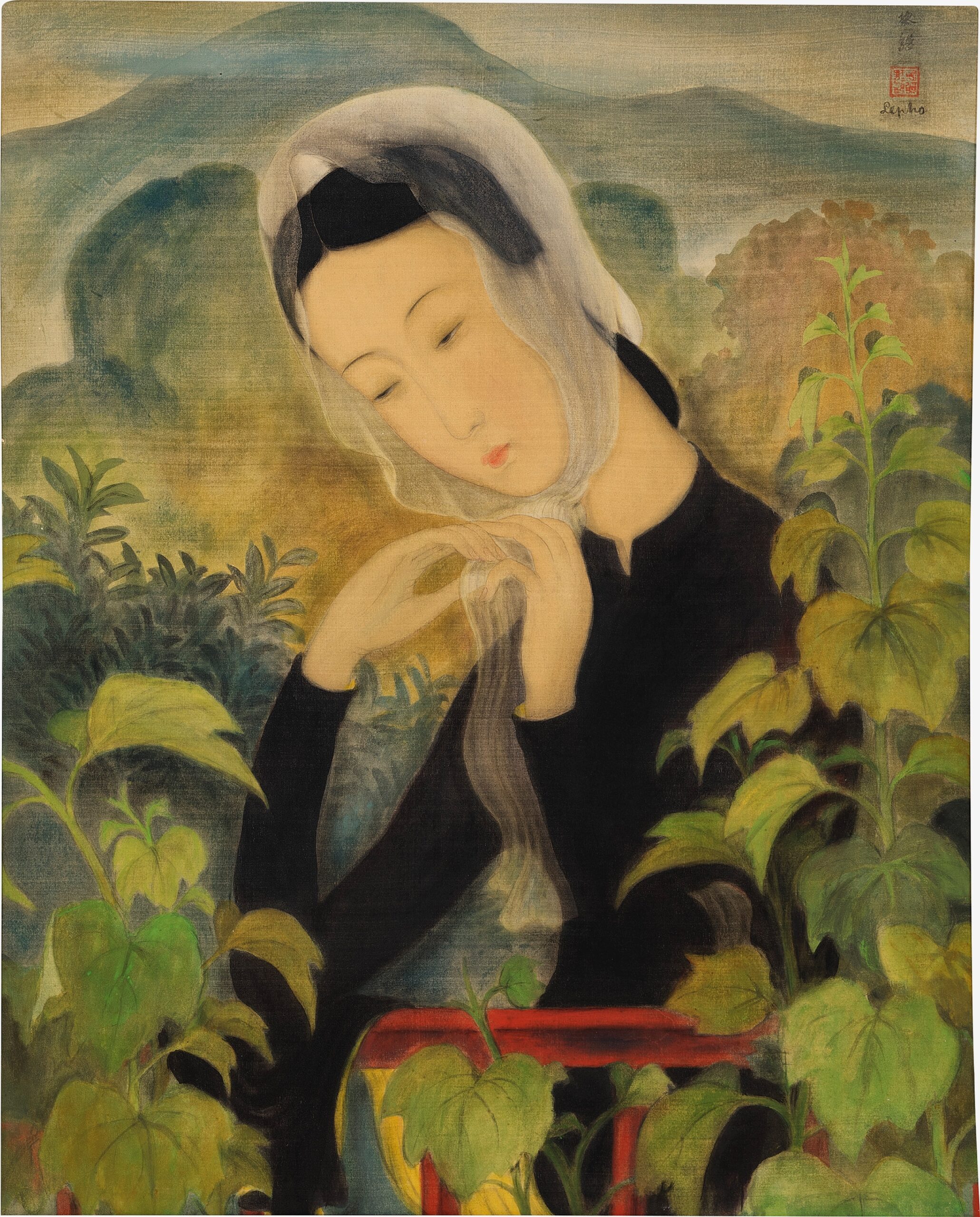
Le Pho (1907-2001)
Jeune femme attachant son foulard (Young Lady Tying Her Scarf)
signed in Chinese and signed again ‘Le pho’ (upper right)
ink and gouache on silk
59.5 x 48.5 cm (23 3/8 x 19 1/8 in.)
Painted circa 1938
one seal of the artist
The year 1938 is undoubtedly a pinnacle year in Le Pho’s oeuvre.
Indeed, he had returned to Paris in 1937 for the second time, after a first stay in 1931-32. This followed his appointment as a full professor at the Hanoi School of Fine Arts in 1933, interspersed with a short stay in China in 1934. His travels across Europe and Asia made him experience a peaceful ‘confrontation’ and confluence between East and West, Vietnam and France, which inspired him throughout his work, further empowered by an impeccable technique.
The subject Jeune femme attachant son foulard would be the driving force through Le Pho’s life, it is a gift of an endless source of inspiration. Geography and memories feed his unique and irreplaceable work well beyond his major themes (longing for his birth land, the mythologized woman) and well beyond his techniques (oil on canvas, gouache and ink on silk and lacquer). One can only appreciate the accuracy of the lines and the subtlety of tones enhanced by the substantial use of ink to paint.
The painting we are proud to present here is clearly an extraordinary work - a milestone in the master’s creation which uses at the highest level all the same classical elements usually found in all of Le Pho’s paintings at that time. The fine features of the lady’s diaphanous face, her headdress, her black ao dai (a rare colour for such a garment), the white veil, the abundant vegetation, all set in a mountainous landscape of Tonkin, are expressed here with real originality.
The precise choices of plants on the foreground as well as background are very relevant. Le Pho was very fond of flowers and frequently reproduced them in his pictorial work, whether in vases or pots or decorating nature in which he placed his characters. And the artist was a great connoisseur of these flowers from North Vietnam, the list of which is very long, from peonies to jasmines, gladioli to orchids, periwinkles to lotuses. We must therefore pay attention to the green plants in which he literally surrounds our beautiful young female protagonist here. In this particular work, and what makes it also outstanding, is the representation of common plants. Here are Hollyhock flowers which blossom at the early onset of spring, which legend says are a faithful companion providing protection, warmth and shelter. Our lady here looks like a budding flower, gracefully emerging from within this luxuriant cradle of flowers.
The representation of the mountains in the background is also particularly interesting. The artist depicts them far away and unreachable, far behind the lady’s figure who is leaning on a wooden rail, her ao dai draped under her elbow to reduce the hardness of the rail. Perhaps the symbolism being a somewhat nostalgic longing for the homeland he had just left.
In front of the powerful grace of the Tonkinese Lady, her nostalgic and sensual facial traits succumb to the power of her gesture: she doesn’t touch the wild plants, she intends with her graceful hands to reinforce the knot.
While painting this work around 1938, Le Pho had probably already made up his mind: the choice was to stay permanently in France, a country where he was welcomed with elegance and success in 1931, when he was Victor Tardieu’s assistant during the Paris Colonial Exhibition. The eight million visitors, the international audience, the press coverage, the debates and comments he experienced, it was an intellectual, political, sensory and obviously artistic delightful turmoil that seized Le Pho. Six years later, in 1937, he was no longer just the assistant to Victor Tardieu-Artistic Director of the Angkor Pavilion, where the works of the Hanoi School of Fine Arts were exhibited. He was then Artistic Director of the Indochina section during the Exposition Universelle de Paris (The Universal Exhibition) in 1937, officially the “Exposition Internationale des Arts et des Techniques appliquées à la vie moderne ” (Exhibition of Arts and Techniques Applied to Modern Life), which was held in Paris from May 25 to November 25, 1937. It is again in Paris that everything will be decided, judged and said. Montparnasse is centre of the world for visual art, where all the great masters of the time meet each other and mingle in an atmosphere of permanent quest for the absolute.
When he paints Jeune femme attachant son foulard (Young Lady Tying Her Scarf) , he is then a 31-year-old young man, ambitious and trustful of his destiny, with the modesty known of the greatest, and thus created this beautiful and stunning artwork.
This young and elegant woman, who leaves behind unattainable mountains and who leans momentarily on an easily crossed barrier in the bosom of a generous nature in the making, is Le Pho himself. Because obviously with any painter, any painting is a self-portrait.
Le Pho was undoubtably a lover of women, the reason why, of all the female representations in 20th century pictorial art of Vietnam, he offered the most beautiful, the most elegant and the most sincere representation of women.
By his genius, now universally recognized, he succeeded in making his subject of predilection, a subject of admiration.
Jean-François Hubert
Senior Expert, Vietnamese Art










